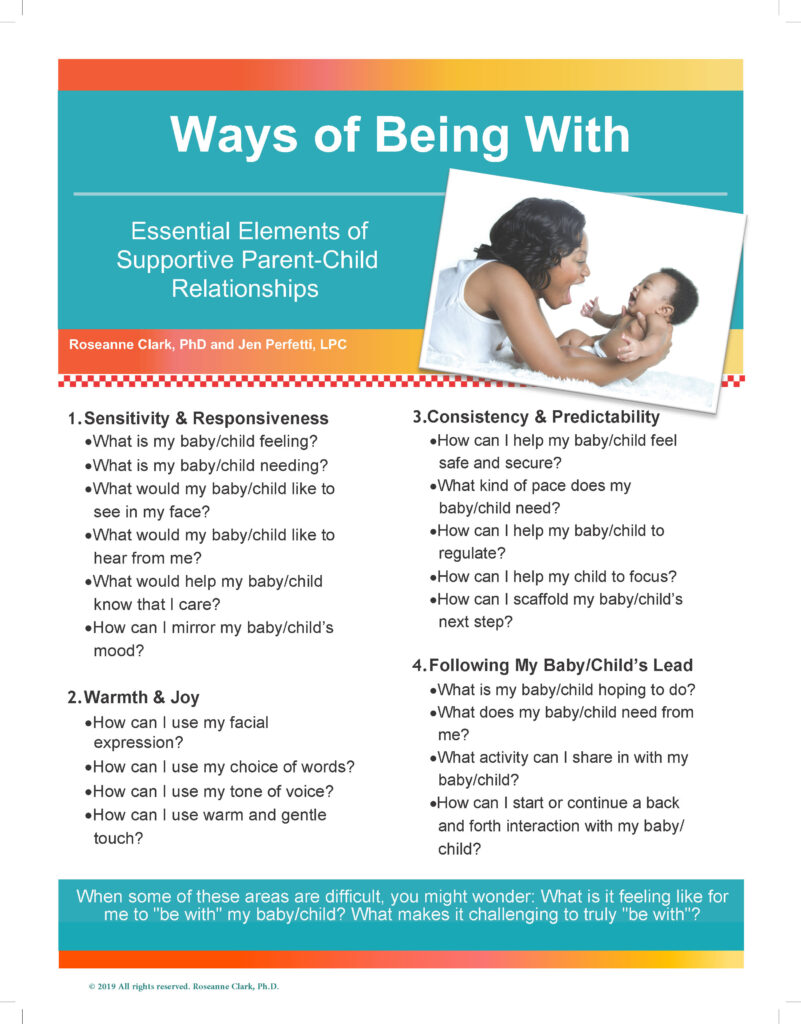The Brief Parent-Child Early Relational Assessment (B-ERA)
The Brief Parent-Child Early Relational Assessment (B-ERA) has been derived from the Parent-Child Early Relational Assessment (ERA), a well-validated assessment of parent-child relationship quality (Clark, 1985, 2006, 2010, 2015) which was designed to measure the quality of affect and behavior in parent-child interactions in relationships that are well-functioning and those at-risk. The domains of functioning in the ERA were selected and item descriptions and anchor points were developed based on theory, developmental studies, and clinical observations of high-risk and well-functioning parent-child dyads.
Just as with the original ERA, the B-ERA uses a global coding approach based on 5 minutes of interaction. The quality of interaction, rather than the quantity of aspects of interactions, may be more relevant to the young child’s experience of his primary relationships. For example, parents can often “go through the motions” (e.g., verbalize a great deal of commands but not use language to mirror or communicate, to extend, or to elaborate the child’s verbalizations or may relate with flat or negative affect). Thus, a macro rather than a micro (e.g., time sampling, frequency count) assessment approach was chosen to attempt to capture the experience, meaning and content of the interaction.
The goal of the development of a brief version of the ERA is in response to requests from professionals across systems and settings who are supporting parents with infants and young children. The B-ERA is a video-based method to identify strengths and areas of concern in the parent-child relationship. The B- ERA, like the ERA, utilizes an assessment and intervention approach that engages the parent in looking together with their provider at their relationship with their child, their own history of being parented, and their sense of mutual enjoyment and difficulty in time spent with their child. The B-ERA process involves video recording the parent and child together engaged in a feeding/snack time, structured task and free play together, coding the video recordings for areas of strength and concern, developing a Relational Profile and conducting a Video Replay Interview with the parent. During the Video Replay Interview, the parent is engaged in exploring how alike or different this time together was, their sense of enjoyment and challenges in parenting this child, and the meaning of their child and their child’s behavior to them. Both the Relational Profile and Video Replay Interview and discussion can then be used to learn what goals the parent has for themselves, their child and their relationship, the types of support the parent would appreciate. The Parent-Child Relationship Development Plan documents these as well as strategies/ approaches that can enhance the parent-child relationship and documentation of progress on the collaboratively developed goals. The change identified through the use of the B- ERA process at different timepoints can help illustrate progress in parent, child and dyadic domains along with documenting overall program effectiveness.
The ERA has been used in more than 500 programs and research projects internationally. Reliability and validity have been documented in both high-risk and normative populations (Clark, 1999; Clark et al., 2004; Clark, R., Tluczek, A., Evenson, A. & Moore, E.L., in press). Psychometric work on the B-ERA is currently underway.
Observation/Video Recording of Parent-Child Interaction
For the purpose of observing the parent-child interaction and to assist in assessing current relationship issues in the dyad, a parent and child are video recorded together for three 5-minute segments of 1) feeding, 2) structured task and 3) free play.
Each of the 3 situations provide a window for understanding what has been shared in the parent-child relationship. Each situation may be experienced differently by different parents, with a range of conflictual feelings and feelings of competence in the parenting role being elicited in each situation.
1.) The Feeding Situation allows us to assess the parent’s capacity for nurturing and social interaction as well as sensitivity to the child’s cues and need for regulation. The child’s readability, affect regulation, social initiative and responsivity during feeding may also be assessed.
Comfort, tension and regulation of the dyad in this situation is observed.
2.) The Structured Task Situation allows us to observe the parent’s capacity to gain, focus and sustain a child’s attention to a task through structuring and mediating the environment while keeping the child’s developmental and individual needs in mind. Some of the tasks tap the child’s emerging abilities and require adult cognitive scaffolding and emotional availability in order for the child to complete the task successfully. The child’s attention, persistence and interest in complying with parental expectations in a structured situation are observed. The dyad’s capacity for joint attention to an activity, reciprocity in negotiations and mutuality may be assessed.
3.) The Free Play Situation allows us to assess the parent’s capacity to be playful with and enjoy their child, to facilitate their child’s capacity for exploratory and representational play. In addition, the dyad’s capacity
for social interaction, mutual enjoyment and reciprocity can be observed.

